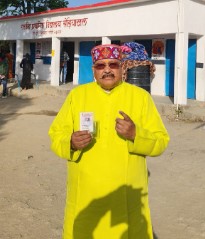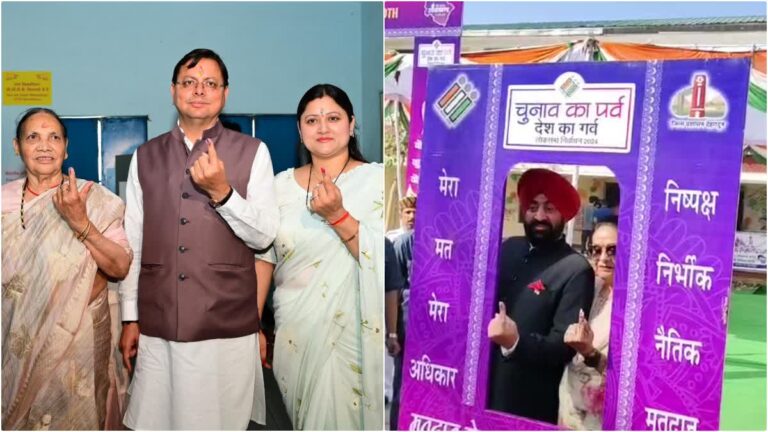This bridge is a witness to hundreds of years of old business of India-Tibet trade
Human walk after 1962 in Gertang Gali of Nilang Valley ..!
This bridge is a witness to hundreds of years of old business of India-Tibet trade!
- Tourists reach Gartang Gali for the first time after 59 years!
- A Rajasthani Tilak Soni has been involved in promoting Gartang Gali and Nilang Valley for the last 10 years!
- Tourism Department releases 25 lakh rupees to organize Gartang Gali!
- District Magistrate Uttarkashi Ashish Srivastava opened the path to Gartang Gali at his risk!
Of course, you become obsessed when you see the mountain and plateau reconcile together. On one side there are high peaks and on the other side, there is such a plateau where there is not a slight foot slipping, that your flesh and bones are not detected as soon as the miles fall into the deep ditch! One such valley filled with immense curiosity, the history of those thousands of years of the Tibet-India silk trade is in its end, the valley of which the Gartang Gali is one of the most famous streets of the world, whose big engineers see the construction art of the bridge. Are surprised.

The Bhairon Valley has located on Uttarakhand’s capital Dehradun to Uttarkashi and 90 km from Uttarkashi to Gangotri Road. Just before the steel bridge over the ‘Jad Ganga’ of the Bhairon Valley goes a walkway to the left to the Nilang Valley from where the distance of Nilang is said to be about 28 km while only two km from the Bhairon Valley. Further, at one end of the ‘Jad Ganga’, a 150-meter long wooden bridge named Gartang Gali has been built, which would surely have remained a mystery-thrill from hundreds of years ago. After seeing this bridge, it seems that its creator, Peshawari Pathan, must have been a magician who built a bridge in that period which is impossible to even think about in the present!

This bridge has been the most mysterious link of Indo-Tibet trade, through which the business relations of the two countries continued for hundreds of years. Two routes are suitable to reach here, the first route from Haridwar via Narendranagar, Tehri, Dharasu, Uttarkashi, Bhatwadi, Gangnani, and Harsil. Neelang Valley can be reached from Dehradun via Mussoorie, Chamba, and Tehri, while others reach Uttarkashi via Dehradun, Mussoorie, Nanbagh, Damta, Naugaon, Badkot, Radi Danda. In 2015, Dinesh Aggarwal, who was the Forest Minister of Uttarakhand, announced to open the valley to the sight of wildlife tourism, while this valley was completely closed for human travails in 1962, during the China-Indian War as a highly sensitive zone. ! The biggest surprise is that even after a dispute arose on this border of Uttarakhand bordering the Tibet-China border, not a single shot was fired till date, yet this terrain was kept closed for almost 47 years.

It is said that the Nilang Valley was always dominated by Tibetan intruders. The residents of this valley have been called Jadh Bhotia, who have never had good relations with Tibetans. There is a temple of Lal Baba here, which some local residents believe to be a lama, and some call it Hanuman. The Nilang Valley was called ‘Chonsha’ by the Tibetan people. It had two villages named Nilang and Jadung. An Englishman, A. Gerrad, referred to it as ‘Chunasakhago’ in 1820, while F. Wilson, who was familiar with the area in the vicinity of the region around the 1850s, called ‘Chungsa Khaga’. Due to the blue mountains, the locals knew it as Nilang. Another foreman, J. B. Fraser, first attempted to visit the region. He went as far as Gangotri but made people aware of the geographical location of the region. He wrote about Nilang i.e. Chonsha and the ‘Jadh Bhotia’ residents of that area. According to records, Captain John Hudson and Lieutenant James Herbert of ‘Survey of India’ were the first Europeans to reach ‘Gomukh’. He arrived there on 31 May 1817. Lieutenant Herbert had returned after two years to find out about the region and finally reached Nilang on 13 September 1817.

British soldier Wilson, who settled in Harsil, also came here after fleeing from the Afghanistan war. Who later bought Harsheel and the surrounding area from Tehri King to make it his fiefdom and brought his currency in circulation with the Tehri King. Legend has it that Wilson was a spy of the British government in the British period and was entrusted with the responsibility of this very inaccessible area by the British government so that the Russian army could not reach India by this route, on the other hand, it is said that Wilson Around 1850, the Tehri King also entrusted the responsibility of settling the area.

The work of repairing the Gartang Bridge is going on at war level
Wilson had built several bridges in this area and had paved the way between Harsil and Nilang. Wilson propagated his self-proclaimed king here and produced a large number of apples of Wilson species known in this area even today Harsil’s Wilson apple is famous. Wilson also wrote a book ‘Mountaineer’ based on his experiences on the region. It is also a coincidence that District Magistrate Ashish Srivastava had worked hard in the last few months to declare Chanshal of Aarkot Bangan region of his district as Trek of the Year 2017, which resulted in the Dronagiri Trek of the Year. Along with 2017, it also had to be declared Trek of the Year.

Udit Ghildiyal on Gartang bridge
At the same time, Udit Ghildiyal, director of High Feed, says that reaching Gartang Gali is really like a dream come true because this 150-meter bridge does not seem less than a Miracle. Udit says that it is the result of the efforts of Tilak Soni that the government was able to focus on it. He is the only person who has left no stone unturned to make Gartang Gali and Nilang Valley important from a tourism point of view.
Journalist Dharmendra Pant writes that CL Griesbach, associated with the Geological Survey of India, visited the Nilang Valley in 1882 and 1883 and did a detailed study here. He has written in ‘Geology of the Central Himalayas’ that when he went to Nilang, the relations between the local inhabitants of Jadh and the Tibetan people were not good. A map of the entire region was drawn up in the 1930s. The British explorer J. B. Ouden (younger brother of the great poet Wiston Hugh Ouden) reached the Nilang Valley in 1939 exploring the tributaries of the Bhagirathi. He later played an important role in getting the map prepared here.
There is also an interesting incident involving Nilang Valley. Two Austrian mountaineers, Heinrich Herrer and Peter Offsenator came to India to climb Nanga Mountains, the ninth highest peak in the world, but in 1939 the Second World War broke out. The British government kept both these climbers imprisoned in Dehradun. The family also did not support him and even Herr’s pregnant wife Ingrid sent divorce papers for him from Austria. In 1944, Herrer and Offsenator managed to escape from prison. They reached Tibet through the hidden Nilang valley. Herrer was also the Guru of the Dalai Lama. Later, he wrote a book on the days of his escape from jail and then reaching Tibet through the difficult Himalayan paths, Nilang Valley, etc. and was called ‘Seven Years in Tibet’. Later in 1997, a film with the same name was also made.
Last September 27, 2017, on World Tourism Day, a 25-member team led by SP Uttarkashi has again made a stroll in this area, which includes Vikram Malik, a well-known resident of Gurgaon, Tilak Soni, group promoter of Ware Eagle Dare, Times of India Editorial Subodh Ghildiyal of the group, blogger Mayank Arya, director of High feed Udit Ghildiyal, Seema Sharma of Times of India, Shailendra Thukral from Delhi and his wife from Delhi Rajasthan and foreign tourists joined!

After 49 years, the first tourist group reached Gartang Gali
It is not that the entry of common people in this valley has been forbidden, but outsiders have not been able to enter this valley before this, on the sources believe. People here say that this bridge of Gartang Gali is so wide that you can take a yak laden with luggage in it, while Udit Ghildiyal says that there is so many such Danger Zone in this street, where there are many meters of wood visible in the air. He told that the team went only two or three meters to the bridge of Gartang Gali because the work of repairing this bridge is going on very fast which will definitely be able to bring tourists from all over the world in the coming years!
Remind you that until this street was built, the Tibetan merchants used to measure miles of Himalayan highlands and reach India for trade with their yaks. Many times yaks and traders were buried in snow due to those inaccessible paths. That is why this street was constructed earlier by the Peshwari Pathans. Information about when this construction work started has not been received in reality, yet the natives here consider it a bridge hundreds of years old. There are many villages of Jadh Bhotia people in which Sonam, Tripani, Pulam, Sang, Sumla, Mendi, etc. are prominent. Built on the plateau terrain of the Ganges Ganga, 25 km away from Gartang Gali, 8 km from Nilang and Nelang, Naga and 15 km from Naga are Jadung and Nilapani! People believe that the Garhwali army, under the leadership of Madhau Singh Bhandari and Veer Bhad Lodhi Rikhola, continued the conquest of Dwapa (Tibet) by this route.

Rare Sheep Argali
Wildlife Institute of India has captured the movement of the very rare sheep Argali in this area by its cameras. For your information, let us know that this wild sheep named Argali, it is believed that it lives in the same part of the Uttarakhand state of India besides Tibet and Kazakhstan in the world.
However, in the coming days at a height of about 10,800 feet above sea level, many climbers will have their feet fixed but they will have to wait a bit more because Uttarakhand tourism has allocated the budget to develop it and Work is also going on fast to settle. At the same time, the district administration Uttarkashi has started working on it with the tourism department. Tourism Minister Satpal Maharaj and tourism secretary Meenakshi Sundaram deserve congratulations!
By Manoj Ishtwal







